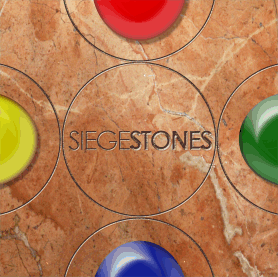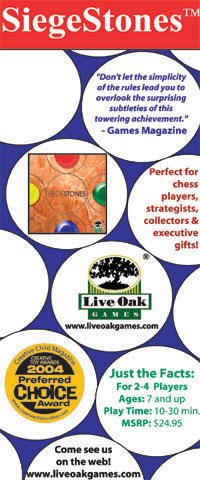

Like most abstract strategy games SiegeStones doesn’t have a target age. They’re fun for all ages. In testing, we found that children younger than seven had a difficult time, so we set the minimum age at seven.
The empty board can be a little daunting. Just pick up one of your stones and put it on the board (inside a circle). Your opponent will do the same. You’ll catch on pretty quick. When you’re ready to place a tower, go ahead.
No. After each turn, score the board by adding up the threat of the stones around each tower. Change the stone on top of the tower to whatever color threatens it the most. This is a vital part of the game. A fun strategy is to set up chain reactions - where your opponent loses control of two or three towers in one turn.
Like most abstract strategy games SiegeStones doesn’t have a target age. They’re fun for all ages. In testing, we found that children younger than seven had a difficult time, so we set the minimum age at seven.
The empty board can be a little daunting. Just pick up one of your stones and put it on the board (inside a circle). Your opponent will do the same. You’ll catch on pretty quick. When you’re ready to place a tower, go ahead.
No. After each turn, score the board by adding up the threat of the stones around each tower. Change the stone on top of the tower to whatever color threatens it the most. This is a vital part of the game. A fun strategy is to set up chain reactions - where your opponent loses control of two or three towers in one turn.
When you're scoring the board, don't take stones off the board! In fact, you never take stones off the board. When you're claiming a tower, use a stone from your pile of stones.
With the first edition of the game, there were only nine towers in the box, which sometimes caused players to run out. The second edition has 12 towers in it - so probably you won't run out.
However, it's still a good idea to keep an eye on the number of towers. If there's a tie on the towers, whoever has placed the most stones wins. If you can convince your opponents to place the towers, you will have more stones on the board at the end.
In fact, I think the "perfect" game is one where you place no towers at all and still win.
No. The first player has an advantage in the case of an even tower count, but that's rare in a two player game. In a 3-player game, the middle player can have a slight disadvantage, unless they start strong.
In a four player game, the first person arguably has an advantage (because of the common occurrence of two or three tower wins).
In a two player game, there are a couple things to keep in mind. One is that the corners are positions of strength. Because the corner space has fewer adjacent circles, you can control a tower with only two stones, and that's pretty powerful.
It's tough to take a corner when you have an experienced opponent, though. Another position of strength is adjacent stones.
Another strong move is to place two adjacent stones and then put a tower on either side of them (so each tower threatens each stone). This has two stones controlling two towers, and that's a great ratio. There are lots of "strong" moves like this. The game boils down to gaining control of the board and being in position to make your move for four towers.
Okay, this one is embarrassing. After a great deal of development and testing and editing, my brain apparently turned off. I was sure there were 39 circles. There aren't. There are only 37. I suppose you could count the "circle" of people playing, and the "circle" of... nah. It's purely a misprint. 37 circles. Fortunately, the second edition has that corrected.
That would be me. My name is Pat Matthews, and I'm the designer. If you have any other questions, or would just like to chat a bit, please use my contact page.